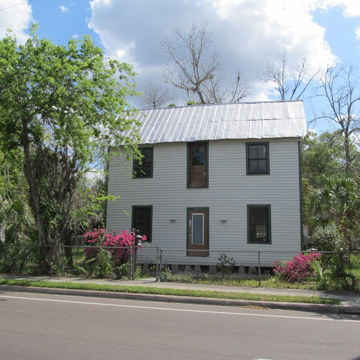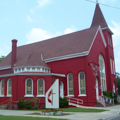Gainesville’s oldest and largest continuously inhabited Black neighborhood is located along Pleasant Street, northwest of the city’s original boundaries. This land, on part of what was known as the Brush Addition, was acquired in 1856 from the estate of Nehemiah Brush two years after Gainesville was incorporated. The land was platted in 1859 and extended the city's boundaries from University Avenue (then called Liberty Street) north to present-day Northwest 8th Avenue (then called Boundary Street). After the Civil War, emancipated people relocated to Gainesville, where they could buy land and establish churches, schools, and businesses. Employment was readily available for the skilled workers, including tailors, blacksmiths, shoemakers, carpenters, and teamsters, who arrived from throughout the South. The southern part of Gainesville largely remained a white residential area.
The Pleasant Street neighborhood hosts a collection of shotgun houses, bungalows, and other Queen Anne, Colonial Revival, and Stick Style residences. Dwellings are almost all single-family residences with a few businesses and schools tucked into the mix. The neighborhood contains broad streets and sidewalks lined with large trees and small house gardens and lawns with picket fences. The neighborhood was home to many of the Black men who were elected to local and state offices, including Theodore Gass, Matthew M. Leavy, Alexander DeBose, George Smith, Lawrence Chestnut, Reverend Trapp, Primus Player, Isaac Davis, Jennings Feltner, and the Martin brothers, as well as J. T. Walls, Florida’s first Black congressman. A poll tax and Jim Crow restrictions disenfranchised Black residents in the late 1890s, and the district became more segregated and isolated, which resulted in the growth of many Black businesses, including stores, insurance agencies, doctors' offices, and a sawmill. In 1936, Jackson and Sophronia Dunbar opened a hotel on Grove Street (now NW 4th Street). The Dunbar Hotel was Gainesville’s only hotel to serve Black travelers until the 1950s, and hosted such celebrities as Ella Fitzgerald, Duke Ellington, B.B. King, and others performing at the nearby Cotton Club on the Chitlin’ Circuit. The two-story, clapboarded structure featured a double veranda beneath a central gable on its main facade.
In addition to social halls and theaters, the neighborhood also contained various educational and religious institutions. Of particular note is Mount Pleasant Methodist Church (620 NW 2nd St.), the oldest Black congregation in the city. Freedmen built the original structure in 1867, which was destroyed by fire and replaced by the current red brick, Romanesque Revival structure in 1906. One block south is the Friendship Baptist Church (426 NW 2nd St.), originally built in 1888 and replaced after a 1911 fire with the current building: a vaguely Gothic Revival structure built of rusticated concrete block and featuring stained glass lancet windows. The Union Academy, established by the Freedmen’s Bureau in 1867, served as Gainesville’s central Black educational institution until 1923, when new segregated schools were built by bond issue. Local Black artisans volunteered their time to erect the single-story frame structure, which featured a veranda, an unusually large front gable, and a belfry; it was enlarged toward the rear in 1883 and with a second story in the mid-1890s. After Union Academy’s closure, Black students attended the two-story brick Lincoln High School on Northwest 7th (then Columbia Avenue). The Union Academy served as a retirement home for a time before its demolition in the 1960s.
Today there are over 250 buildings erected in the post–Civil War era and the early twentieth century that contribute to the historic district, which was added to the National Register of Historic Places in 1989 thanks to the work of the Pleasant Street Historic Society, an organization founded in 1984 with the goal of preserving and revitalizing the neighborhood. In 2003, Claronelle Smith Griffin bequeathed her house (321 NW 8th Avenue), built by her great-grandfather in the 1870s and later enlarged, to the Pleasant Street Historic Society with the goal of creating a museum highlighting the contributions of the African American citizens of Gainesville and Alachua County. In recent years, the Pleasant Street Historic District has undergone significant changes. New single- and multi-family housing has been erected on vacant lots, and many of the older shotgun houses and bungalows are being renovated. Due to its proximity to downtown and the University of Florida, students and young families are flocking to the neighborhood.
References
Cunningham, Ron. “Pleasant Street sees new investment, new neighbors.” Gainesville Sun (Gainesville, FL), September 7, 2019.
Laurie, Murray D. “The Union Academy: A Freedmen's Bureau School in Gainesville, Florida.” The Florida Historical Quarterly 65, no. 2 (October 1986): 163–174.
"Narrative Information for Pleasant Street Historical Society’s ‘Ancestral Gainesville’ Presentation." Samuel Proctor Oral History Program. Accessed May 20, 2021. https://oral.history.ufl.edu/.
Pickard, Ben. Historic Gainesville: A Tour Guide to the Past. Pamphlet. Gainesville, FL: Historic Gainesville, Inc., 1990.
“Pleasant Street Historic District.” Explore Historic Alachua County. Accessed May 20, 2021. http://www.explorehistoricalachuacounty.com/.
Shiver, W. Carl, “Pleasant Street Historic District,” Alachua County, Florida. National Register of Historic Places Inventory–Nomination Form, 1989. National Park Service, U.S. Department of the Interior, Washington, D.C.
Talbot, Joanna Grey. “Dunbar Hotel.” Florida Revealed, March 17, 2020.



















